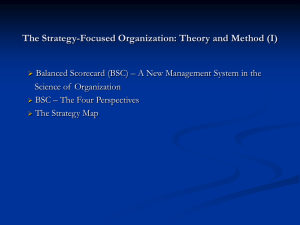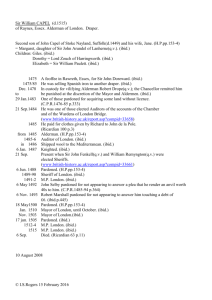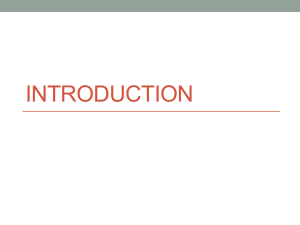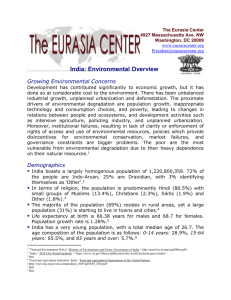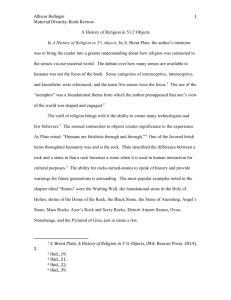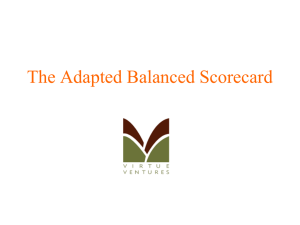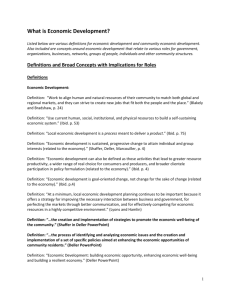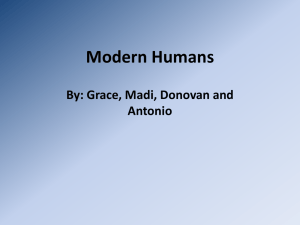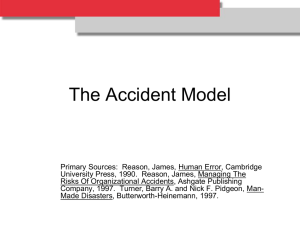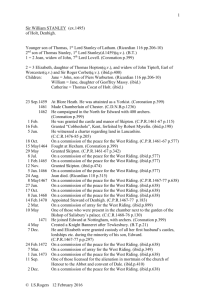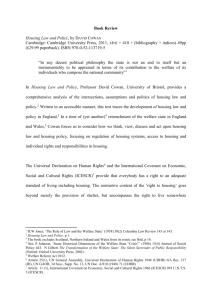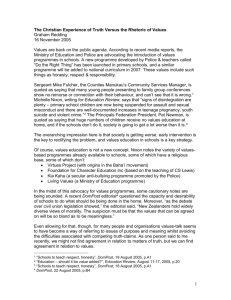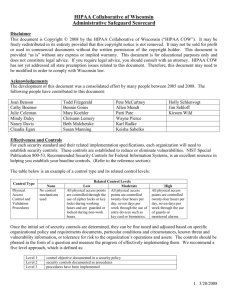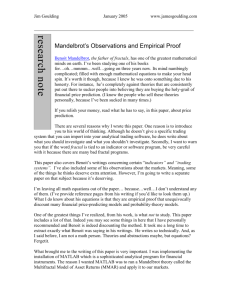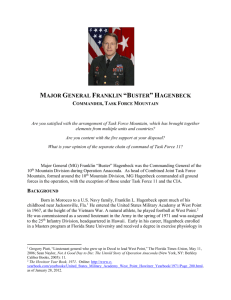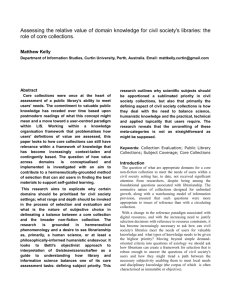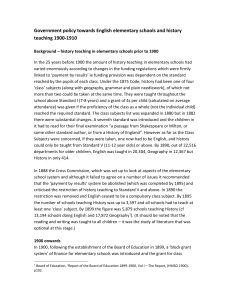The Strategy-Focused Organization: Theory and Method (II)
advertisement
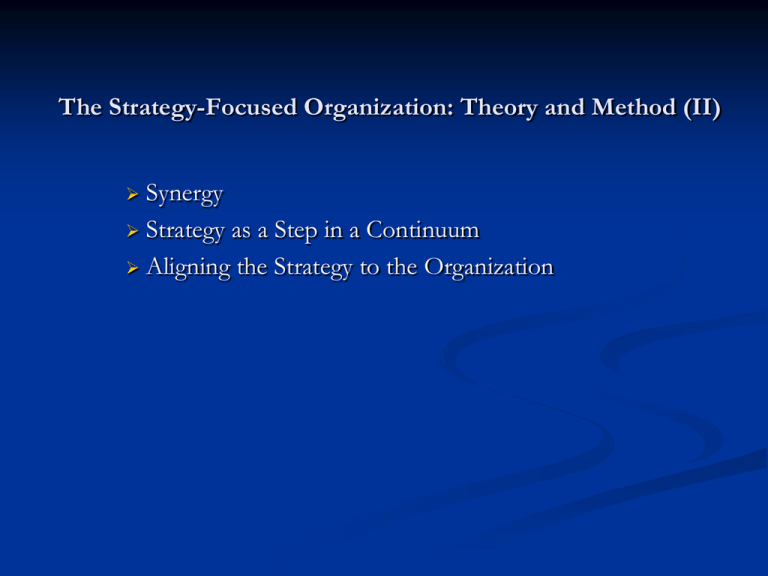
The Strategy-Focused Organization: Theory and Method (II) Synergy Strategy as a Step in a Continuum Aligning the Strategy to the Organization Synergy Synergy = “The combination of factors which each multiply the effects of the other(s) rather than merely adding to them.” [i] When the whole resulting from employing organizational resources and capabilities exceeds the sum of the parts we may speak of a special global effect that is its synergy. [i] Source: www.llrc.org/jargonbuster.htm Illustration: Market Value Added: General Motors & General Electric compared General Motors Market value - Capital Employed = Market Value Added Revenues Employees Profits General Electric $62 billion $176 billion ($83 billion) ($54 billion) = - $21 billion = +122 billion $169 billion $70 billion 709 000 222 000 $5.0 billion $7.3 billion Source: Lowe, Julian. Strategy and Management of Change, Understanding Strategic Performance The synergy allows the organization to transform the sum of its numerous sectors, business units, departments, different functional areas such as finance, manufacturing or sales into a whole exceeding their mere sum, resulting into a new type of organization that display a new feature of being a strategy-focused organization. Synergy has the power of transforming an institution “traditionally designed around functional specialties”, each function having its own “body of knowledge, language and culture”, therefore, being fragmented by major barriers, into a strategy-focused organization. It is surprising to see how a functional-oriented organization leaves its place to a highly focused organization that break through the former barriers between the functional specialties of the same company. “Executives replace formal reporting structures with strategic themes and priorities that enable a consistent message and consistent set of priorities to be used across diverse and dispersed organizational units. Business units and shared service units become linked to the strategy through the common themes and objectives that permeate their scorecards. Often, the ad hoc organizations emerge to focus on scorecard strategic themes.”[i] We have to underline the new concepts arising from such an approach: the organizational process, the strategy-focused organization, the ad hoc organizations (emerged to focus on strategic themes). These concepts add themselves to the traditional approach of the organizations and together with the above mentioned concepts required by the strategic management approach of a company – the strategy map, the Balanced Scorecards, the cause-andeffect linkages, the synergy as an overarching goal of the organization –lead to rethinking of the science of the organization in a revolutionary way. [i] Kaplan, Robert S., Norton, D. (2001). Op. cit ., p. 12 The science of organization keeps its pace with the new type of economy that emerged with the beginning of the new millennium. This new approach which is tantamount to a new paradigm sanctions the triumph of weberian perspective on the economy and organizations. The ethos has a crucial role in promoting a new historical type of economy. The new operating management system focused on the strategy and on the intangible assets is the equivalent within the organizational strategic approach of the weberian concept of ethos. Coming back to the operational aspects of the strategic approach we should, further, stress out that it illustrates a topological research perspective in the study of a company as long as such an approach requires to look for other spaces of attributes or variable describing the ad hoc organizations emerged to focus on scorecard strategic themes. Kaplan and Norton gave an example of such a topological analysis applied to a retail firm for women’s clothing (see next slide). Sourcing and Distribution Theme Measurement Target Initiative • • • 20% increase 12% increase • Likes Program Reduce by 50% each year 60% 2.4 Units Quality Management Customer Loyalty • Corporate Factory Development Program • Strategic Skills Plan Merchants’ Desktop Financial Profitability Revenue Growth Customer Product Quality Shopping Experience Internal “A” Class Factories • Operating Income Same growth - Return rate Quality Other Customer loyalty Ever active # units Merchandise from “A” factories Items in stock • • 70% by year 3 85% % of strategic skills available Strategic systems vs. Plan Year 1 (50%) Year 3 (75%) Year 5 (90%) • Line Plan Management Learning • Factory Relationship Skills store Merchandise Buying/Planning Systems “The strategic theme describe the “recipe” for combining the intangible ingredients of skills, technology, and organizational climate with internal processes, such as sourcing and distribution, to create tangible outcomes – customer loyalty, revenue growth, and profitability. In this way, the Balanced Scorecard provides the measurement and management framework for knowledge-based strategies.”[i] [i] Ibid., p. 72 Strategy as a step in a continuum We have to make some additional specifications to the concept of strategy. Strategy is “one step in a continuum”. It corresponds to the operational act of defining “the logic” of how a vision proposed by a leader could be achieved within an organization. The strategy makes credible a vision. It can even “quantify” a vision, as Gerry Isom proceeded immediately after the moment he accepted the presidency of the division of a well-known company (CIGNA’s Property & Casualty Division). The management process, therefore, involves many steps, starting with the mission of an organization (“why we exist”) continuing with the “core value” (“what we believe in”), the vision (“what we want to be”), followed by strategy (our game plan), the Balanced Scorecard as the step of implementation within this continuum, strategic initiatives (what we need to do), personal objectives and, finally, the strategic outcomes. [i] [i] See Kaplan, Robert S., Norton, D. (2001). Op. cit., p. 73 All these steps are sequences in a continuum which we have chosen to call organizational process. This perspective makes explicit that an organization is not merely a static structure but a strategic organizational process. “The process begins in a top down fashion, clearly defining strategy from the perspective of the shareholder and customer.” [i] “It asks «What are the financial objectives for growth and productivity?» (…) Once the financial objectives have been specified the process continues by asking, «Who are the target customers that will generate revenue growth and a more profitable mix of products and services? What are their objectives, and how do we measure success with them?» The customer perspective also should include the value proposition, which defines how the company differentiates itself to attract, retain, and deepen relationships with targeted customers.” [ii] [i] Ibid., p. 76 [ii] Ibid., p. 76 “Financial and customer objectives are desired outcomes, but they don’t explicate how to achieve them. The internal business processes – such as product design, brand and market development, sales, services, and operations and logistics – define the activities needed to create the desired customer value proposition and differentiation, and the desired financial outcomes. The forth perspective recognizes that the ability to execute internal business processes in new and differentiated ways will be based on the organization infrastructure; the skills, capabilities, and knowledge of employees; the technology that they use; and the climate in which they work. We refer to these as the learning and growth factors.” [i] Ibid. p. 76 [i] The four perspectives are not merely perspectives on the organization but, in the same time, they are organizational frameworks of the activity and reference frames of how to think, how to act, to do things so that, finally, the desired outcomes should be achieved. What is even more relevant is that each of these four perspectives describes or indicates a latent organization that become manifest if and while the target indicators (which appears to the employees as the exigencies) are accomplished. We can see that “the architecture of the Balanced Scorecard has a top-down logic, starting with the desired financial and customer outcomes and, then, moving to the value proposition, business processes, and infrastructure that are the drivers and the desired outcomes constitute the hypothesis that define the strategy.” [i] [i] Ibid., p. 77 Source: Value Based Management.net. Available from: http://www.valuebasedmanagement.net/methods_balancedscorecard.html They are “focused themes” of a certain strategy and they allow the organizations “to deal with the conflicting priorities”[i] in order to make decision on a bipolar axis between opposite alternatives such as: “growth versus profitability” or “long-term versus short-term”. The strategic themes reflect the corporation executives’ view of what must be done internally to achieve strategic outcomes.”[ii] [i] Ibid., p. 78 [ii] Ibid., p. 78 Aligning the Organization to the Strategy What is an organization viewed from a strategic management perspective? It consists, mainly, of “multiple business units”, “multiple divisions” and it appears us as a “collection of shared service units”. A difficult goal emerges for such organizations: “to link their scorecard, developed at the corporate or division level, down to their decentralized organizational units.”[i] To do this involves creating “alignment and synergy across the organization”[ii]. In order to implement its strategy focused on customer, Mobil company gave it up to its centralized organization by replacing it with a new one consisting of 18 geographic business units. [i] Ibid., p. 44 [ii] Ibid., p. 44 “In addition, the previously centralized staff functions had been transformed into 14 shared service units (e.g. information services, finance, planning and analysis, human resources, and environment and safety) that had to sell services to the local business units and get agreement from them on prices and levels of service provided.”[i] Two challenges emerged from such a new organizational situation. The first one was referring at how to keep these 18+14 units, which were working as different entities, “focused on the same high level strategy”[ii]. The second one was referring at upgrading “the skills of the newly appointed heads”, knowing that the business units heads “had grown up” within the old organizational structure, that is “within a structured, top-down, functional organization.”[iii] [i] Ibid., p. 44 [ii] Ibid., p. 44 [iii] Ibid., p. 44 The transition to the new organization had to start with the upgrading the skills of the top executives. Here is the witness of one of them: “We were taking people who had spent their whole professional life as managers in a big functional organization, and we were asking them to become the leaders of more entrepreneurial profit-making businesses, some with $1 billion in assets. How were we going to get them out of their historic area of functional expertise to think strategically, as general managers of profit-oriented businesses?”[i] The Balanced Scorecard proved to have the power “both to create strategic awareness and skills among the new units managers”[ii]. It revealed to work optimally as a mechanism proper to attain such a goal to create a new strategic potential and “to align the strategies of the decentralized units with each other and with the division”[iii]. The leadership team created the scorecard as a “template” to be multiplied elsewhere in the organization. [i] R. S. Kaplan, “Mobil USM&R (A): Linking the Balanced Scorecard”, 9-197-025 (Boston: Harvard Business School, 1996), p. 44 [ii] Kaplan, Robert S., Norton, D. (2001). Op. cit., p. 44 [iii] Ibid., p. 44 “The template” is a logical construct that can be used in order to build a strategy map, therefore, to describe a strategy and, by doing this, to improve the “quality of executive teams’ insights”. The template is, therefore, a critical reference frame for analyzing different scorecards being used by the Strategic Business Units (SBU) of a company. The management team will compare “the scorecards being used by SBU’s to the template.” “Applying the template to SBU scorecards, executive team could identify gaps in the strategies being implemented at lower levels of the organization and ensure that the high-level strategies were truly reflected on local scorecards.”[i] The templates help us also to keep up the control over a performance measurement system which typically involves “aggregation of stand-alone measures, such as return on capital employed, customer satisfaction, and defect rates.”[ii] We should regard the Balanced Scorecard not only as a method of management research but also as a way of thinking, expressing a state of mind and an organizational ethos, a new evolutionary phase in the evolution of the spirit of capitalism. [i] Ibid., p. 99 [ii] Ibid., p. 99
